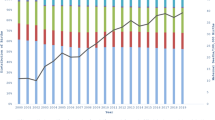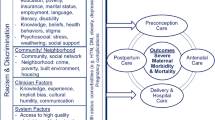Abstract
Purpose
Publications based on data from perinatal health registries reported worse perinatal health outcomes among women of Turkish origin. The aim of this study was to compare the perinatal outcomes of women of German and Turkish origin in Berlin in two time periods and to analyze if the situation among the women of Turkish origin has improved over time.
Methods
Datasets of all singleton deliveries from Berlin hospitals for the time periods 1993–1997 (n = 144,600) and 2003–2007 (n = 147,559) were used. Incidence rates resp. prevalences of perinatal health outcomes were computed for women of German and a group of immigrant women mostly of Turkish origin stratified for ‘parity’ and ‘having a partner’. Logistic regression models were computed to test for a change in the odds for adverse perinatal outcomes over time.
Results
The chances for adverse perinatal outcomes were decreasing in the later time period for most measures. For stillbirth, preterm birth and congenital malformations, no differences between women of Turkish and German origin could be found. Differences exist in the utilization of perinatal health care and in the risk for anemia. Among women of Turkish origin, the chance for being anemic is even higher in 2003–2007 compared to 1993–1997.
Conclusions
The perinatal health measures of women of Turkish origin have improved over time. The lower utilization rates of antenatal health care could be the expression of barriers to access the health care for pregnant women with migration background as offered in Germany. A risk group which needs a special focus by health care providers are women without a partner, irrespective of their origin.
Similar content being viewed by others
References
David M, Pachaly J, Vetter K (2006) Perinatal outcome in Berlin (Germany) among immigrants from Turkey. Arch Gynecol Obstet 274:271–278
Malin M, Gissler M (2009) Maternal care and birth outcomes among ethnic minority women in Finland. BMC Public Health 9:84
Kelly Y, Panico L, Bartley M, Marmot M, Nazroo J, Sacker A (2009) Why does birthweight vary among ethnic groups in the UK? Findings from the Millennium Cohort Study. J Public Health 31:131–137
Troe EJ, Raat H, Jaddoe VW, Hofman A, Looman CW, Moll HA, Steegers EA, Verhulst FC, Witteman JC, Mackenbach JP (2007) Explaining differences in birthweight between ethnic populations. The Generation R Study. BJOG 114:1557–1565
Stoltenberg C, Magnus P, Lie RT, Daltveit AK, Irgens LM (1997) Birth defects and parental consanguinity in Norway. Am J Epidemiol 145:439–448
Alderliesten ME, Vrijkotte TG, van der Wal MF, Bonsel GJ (2007) Late start of antenatal care among ethnic minorities in a large cohort of pregnant women. BJOG 114:1232–1239
Ben-Shlomo Y, Kuh D (2001) A life course approach to chronic disease epidemiology: conceptual models, empirical challenges and interdisciplinary perspectives. Int J Epidemiol 31:285–293
Spallek J, Zeeb H, Razum O (2011) What do we have to know from migrants’ past exposure to understand their health status? A life course approach. Emerg Themes Epidemiol 8:6
Reeske A, Zeeb H, Razum O, Spallek J (2012) Differences in the incidence of gestational diabetes between women of Turkish and German origin: an analysis of health insurance data from a statutory health insurance in Berlin, Germany (AOK), 2005–2007. Geburtsh Frauenheilk 72:305–310
Reeske A, Kutschmann M, Razum O, Spallek J (2011) Stillbirth differences according to regions of origin: an analysis of the German perinatal database, 2004–2007. BMC Pregnancy Childbirth 11:63
Leslie JC, Galvin SL, Diehl SJ, Bennett TA, Buescher PA (2003) Infant mortality, low birth weight, and prematurity among Hispanic, white, and African American in North Carolina. Am J Obstet Gynecol 188:1238–1240
Page RL (2004) Positive pregnancy outcomes in Mexican immigrants: what can we learn? J Obstet Gynecol Neonatal Nurs 33:783–790
Nybo M, Friis-Hansen L, Felding P, Milman N (2007) Higher prevalence of anemia among pregnant immigrant women compared to pregnant ethnic Danish women. Ann Hematol 86:647–651
Endl J, Tatra G (1974) Geburtshilfliche Aspekte bei Gastarbeiterinnen. Wien Klin Wochenschr 86:102–105
Kohne E, Kleihauer E (2010) Hämoglobinopathien—eine Langzeitstudie über vier Jahrzehnte. Dtsch Arztebl Int 107:65–71
Spallek J, Reeske A, Grosser A, Schwabe W, Rieger M, Krahn U, Razum O (2012) Pflegebedürftigkeit bei türkischstämmigen und nicht-türkischstämmigen Säuglingen. Eine Analyse der Pflegegutachten des MDK-Westfalen-Lippe von 2004 bis 2008. Gesundheitswesen 74:485–487
Ringbäck Weitoft G, Haglund B, Rosén M (2000) Mortality among lone mothers in Sweden: a population study. Lancet 355:1215–1219
Razum O, Jahn A (2000) Marital status and maternal mortality. Lancet 355:2169
Acknowledgments
We thank Jürgen Pachaly, Dr. Henning Schaefer, and Tilman Reutter, all from Berlin, for their support to the data preparation and analysis.
Conflict of interest
We declare that we have no conflict of interest.
Author information
Authors and Affiliations
Corresponding author
Appendix
Appendix
Rights and permissions
About this article
Cite this article
Spallek, J., Lehnhardt, J., Reeske, A. et al. Perinatal outcomes of immigrant women of Turkish, Middle Eastern and North African origin in Berlin, Germany: a comparison of two time periods. Arch Gynecol Obstet 289, 505–512 (2014). https://doi.org/10.1007/s00404-013-2986-6
Received:
Accepted:
Published:
Issue Date:
DOI: https://doi.org/10.1007/s00404-013-2986-6




